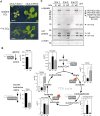Protein lipoylation in mitochondria requires Fe-S cluster assembly factors NFU4 and NFU5
- PMID: 34718778
- PMCID: PMC8825329
- DOI: 10.1093/plphys/kiab501
Protein lipoylation in mitochondria requires Fe-S cluster assembly factors NFU4 and NFU5
Abstract
Plants have evolutionarily conserved NifU (NFU)-domain proteins that are targeted to plastids or mitochondria. "Plastid-type" NFU1, NFU2, and NFU3 in Arabidopsis (Arabidopsis thaliana) play a role in iron-sulfur (Fe-S) cluster assembly in this organelle, whereas the type-II NFU4 and NFU5 proteins have not been subjected to mutant studies in any plant species to determine their biological role. Here, we confirmed that NFU4 and NFU5 are targeted to the mitochondria. The proteins were constitutively produced in all parts of the plant, suggesting a housekeeping function. Double nfu4 nfu5 knockout mutants were embryonic lethal, and depletion of NFU4 and NFU5 proteins led to growth arrest of young seedlings. Biochemical analyses revealed that NFU4 and NFU5 are required for lipoylation of the H proteins of the glycine decarboxylase complex and the E2 subunits of other mitochondrial dehydrogenases, with little impact on Fe-S cluster-containing respiratory complexes or aconitase. Consequently, the Gly-to-Ser ratio was increased in mutant seedlings and early growth improved with elevated CO2 treatment. In addition, pyruvate, 2-oxoglutarate, and branched-chain amino acids accumulated in nfu4 nfu5 mutants, further supporting defects in the other three mitochondrial lipoate-dependent enzyme complexes. NFU4 and NFU5 interacted with mitochondrial lipoyl synthase (LIP1) in yeast 2-hybrid and bimolecular fluorescence complementation assays. These data indicate that NFU4 and NFU5 have a more specific function than previously thought, most likely providing Fe-S clusters to lipoyl synthase.
© The Author(s) 2021. Published by Oxford University Press on behalf of American Society of Plant Biologists.
Figures








References
-
- Angelini S, Gerez C, Choudens SO De, Sanakis Y, Fontecave M, Barras F, Py B (2008) NfuA, a new factor required for maturing Fe/S proteins in Escherichia coli under oxidative stress and iron starvation conditions. J Biol Chem 283:14084–14091 - PubMed
-
- Balk J, Schaedler TA (2014) Iron cofactor assembly in plants. Annu Rev Plant Biol 65:125–153 - PubMed
-
- Bao X, Focke M, Pollard M, Ohlrogge J (2000) Understanding in vivo carbon precursor supply for fatty acid synthesis in leaf tissue. Plant J 22:39–50 - PubMed
Publication types
MeSH terms
Substances
Grants and funding
LinkOut - more resources
Full Text Sources
Miscellaneous

